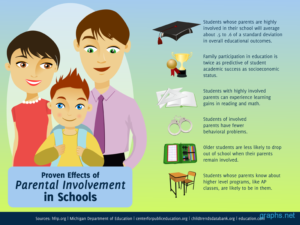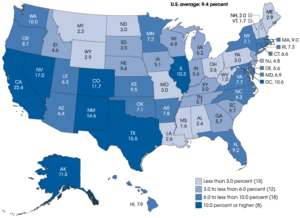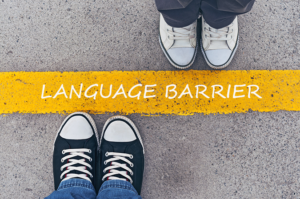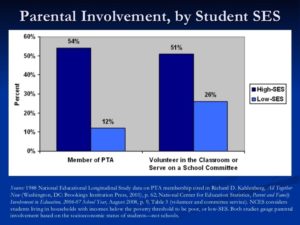Thinking back to my educational experiences growing up, there were many hurdles I had to overcome without the assistance of my parents. This is not to say that they did not want to help, but rather, they did not have the knowledge nor the necessary means to do so. Some might argue that the lack of parent engagement my parents exhibited equated to them not caring. While this is untrue, this narrative is often forced upon the parents of English Language Learners (ELLs) who might not be as involved in their child’s educational studies as other parents without exploring the root of the problem. This can be extremely detrimental and perpetuate false myths about “uncaring parents” in ELL classrooms.
Why is it important to increase parental educational engagement? For starters, this factor has long been seen as a key predictor of school achievement. Studies consistently show that children with involved parents often have better attendance, higher levels of achievement, and a more positive attitude towards school. While increasing parental engagement is a challenge for all parents, those who are parents of ELLs are experiencing additional barriers and impediments during their pursuit to become more involved in their child’s education.

ELLs are one of the fastest growing groups in the United States. Although the numbers have almost doubled in the past 15 years, by 2015, ELL enrollment will reach 10 million. By 2025, it is estimated that one out of every four students will identify as an ELL. In addition, about two thirds of ELLs come from low income families and three out of four ELLs speak spanish, according to the National Education Association.

Although this group is rapidly growing, there are several factors that are not supporting their academic growth, including a lack of effective parental engagement strategies being implemented in school districts and a set of additional barriers. Some of these barriers include language barriers, school-based barriers, cultural differences, and economical barriers.
One of the main obstacles that parents of ELL’s face while attempting to become more involved in their child’s education is language barriers. Whether it is at home or at school, parents who speak limited English go through several struggles that shape the way they are involved in their child’s education. One way that language barriers affect parent engagement at home is not being able to help their child with their homework since parents might not be proficient in the English language. This factor might make parents feel incompetent and make them feel like they are not able to offer the necessary help in their child’s homework.

In school, there may also be language barriers such as a lack of translators who can properly interpret important information regarding their child’s education in a parent’s native language. This, in turn, can create school-based barriers that may influence the amount and the type of involvement from certain parents, especially those who are not proficient in English. Interactions that are not properly catered to the needs of parents can affect communication between the school and the parents, which decreases the opportunity for parents to begin or continue to stay involved. This can also worsen if parents feel like their presence at their child’s school is unwelcome or even isolating due to the lack of bilingual staff. Therefore, it is crucial for schools to have translators readily available and be able to provide information to parents in their native language.

Building on language barriers, linguistic isolation can also be a barrier for parental engagement among ELL students. Almost 70 percent of K-5 ELL students attend schools in 10 percent of the nation’s elementary schools, according to a study conducted by The Urban Institute. This means that students are centered in certain communities and this compromises both students and parents because they have a lack of exposure to English native speakers. Due to this isolation, many parents might live near other parents who do not know how to become more engaged in their child’s education and this might perpetuate the lack of parental engagement.
Another obstacle that parents of ELL’s face while attempting to become more involved in their child’s education are cultural barriers. Parents might have a different view about their role in their child’s education based on cultural values or beliefs. This can serve as either a facilitator or barrier with parental engagement. For example, in some cultures, the teacher is always highly respected and are considered to know what is best for every child’s education. Parents tend to be much more trusting and dependent on the school, so questioning a teacher’s methods or asking a teacher questions about their instruction would be a form of disrespect. Although it is common and encouraged for parents to be highly active in their child’s education, the misalignment in cultural beliefs may serve as a barrier for parental engagement.

These cultural barriers might also extend to a lack of awareness and use of services in the community that might serve as an important tool for a child’s education. Parents might think that using community resources might challenge a teacher’s job. Although this is false, it is important for schools to work with community services and make sure that parents are aware about additional resources that are available to ELLs and parents. If possible, schools should also partner with organizations that offer bilingual resources and make sure that parents know about them.
In addition, parents of ELL students might think that their role in their child’s life is to solely be nurturing and provide good behaviors, values, and collectivism. A study found that a common trait about ELL families is that they value interdependent relationships as well as the importance of extended families. These values are equally important, so it is crucial for teachers not to assume that parents do not care about their child’s education. Instead, teachers should strive to learn more about the background of the students they teach and help bridge the divide.
By having teachers recognize the values that are taught at home, they can also find ways to incorporate them in the classroom and create a holistic teaching curriculum that supports the full identity of their students. This can be done by inviting both parents and extended family members to school activities so that the cultural values of families are also being taken into consideration when being taught. The cultural capital that parents provide is important and schools can find ways to include that in classrooms in order to increase parental engagement. With this said, it is important to look at what families offer through an asset-based approach rather than have a deficit-based mindset on what parents lack.

Another barrier that limits the amount of parental engagement from ELL parents has to do with economical barriers. Parents of ELL’s often have very labor-intensive work schedules and this can serve as a barrier for parental engagement because they might not be able to attend events at school such as student-parent conferences and open houses organized at school. In addition, some parents might not have access to readily available transportation in order to access school events. These two factors combined would make it both financially straining and stressful for parents to become actively involved in their child’s education while also jeopardizing their job. All of these economical barriers might impede parental engagement, but this does not mean that they do not care about their child’s education. In order to increase the performance of both schools and the students they are serving, it is in the benefit of the schools to facilitate parental engagement. By doing so, they will be able to tackle the challenges at hand as well as be more accommodating with the work schedules of all parents and make sure that they are providing different time slots for patents to be more engaged in their child’s education.
In order to help all students achieve, schools and parents need to work together in order to increase parental engagement. Otherwise, the results can be devastating and continue to hurt students and their academic success. It should not always be what parents can do for the school, but rather, what resources can schools provide both students and parents. It is important to have both parties collaborate with one another in order to increase parental engagement and make sure that they are doing what is best for the children. That way, parents are given the opportunity to be active in their child’s education and learn how to be an advocate for them as well.
What schools can do to help parents become more involved in their ELLs education?
- Help parents of ELLs feel like their presence is welcome at school. This can be done by hosting parent education workshops specifically for parents of ELL students and provide parents with guidance on effective techniques for reading to their child and supervising their homework.
- When hosting workshops, provide additional resources to help improve meeting turnout. This can be done by being accommodating to parents’ scheduling, providing child care, and offering transportation options.
- Make sure to have a bilingual interpreter readily available to assist parents when needed. Interpreters are especially essential during parent-teacher conferences, open house nights, PTA meetings, and for regular communication purposes.
- Translate all school documents and any written communication that are sent home. This will keep parents up to date on what is happening at school such as school events, homework, and report cards.
- Arrange home and community visits. This can help establish important relationships with parents of ELLs who may feel intimidated to visit schools for various reasons. Make sure to be considerate of their availability and bring an interpreter if necessary.



